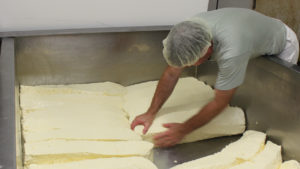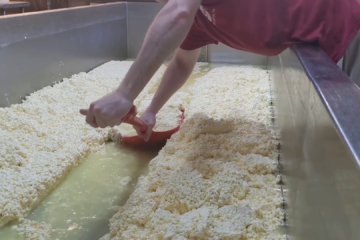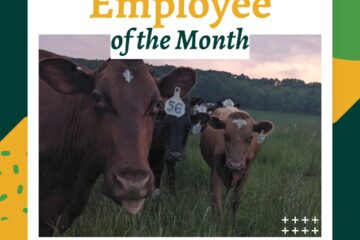Did you know that in cheesemaking, cheddaring is a verb? Cheddaring is a process that cheesemakers use to further acidify the curds and draw more whey out. This process is what allows cheddar cheese to last a long time. But, before we can get to the cheddaring process, first we have to cook the curds. Not sure how we got from milk to curds? Check out the previous post in this series.
During the cooking process of making Clover, we heat the curds and whey up to 102 degrees Fahrenheit. We heat slowly over half an hour to an hour to allow the curds to slowly shrink and become firm. We continue to stir them for another half hour to let the curds reach just the right texture and acidity level.
Once the curds are just right, we push all of them to the back end of the cheese vat and drain off all the whey. We have a drain on the floor that feeds into large totes outside. We use the discarded whey as an additional source of nutrition for our young calves. It is an excellent source of energy and protein for them.

Once all the whey drains out, we pile all of the curds together in the center of the cheese vat. We cut the pile into long strips or slabs of cheese. These slabs are laid across the bottom of the cheese vat. Every fifteen minutes for an hour and a half, we turn and stack the slabs. This is the cheddaring process. After each turn, the slabs consolidate and the curds are firmer as more whey drains out.
Once the cheddaring is complete, the next step is to mill the curds. We cut the slabs into small slices and then run them through these french fry cutters so that we end up with many small strips. We do this to allow for even salt distribution throughout all the curds. Watch as we operate the milling machines in the video below.
Once all the curds are cut down into tiny strips, we begin to add salt. We divide the salt into three portions and stir it in slowly over a half hour, to continue to draw the whey out. Salt also brings out the flavor, making this is the best time to taste the curds. They are nice and squeaky against our teeth! Salt also acts a preservative, helping the cheese age well over the next few months or years.
And that is what makes cheddar a cheddar. Just a few extra steps that add a few hours to our make process. Next month it will be time to explain how we get from a pile of curds to a wheel of cheese.
NEXT: Hoops & Followers



3 Comments
ART · December 8, 2024 at 9:00 pm
Do you I have any aged cheese? Like a few years or older.
Thanks
Anthony Rice · December 8, 2024 at 9:13 pm
The oldest cheese we have right now is Royer Mountain at 15 months and Moshannon at 12 months.
Arthur Lersch · December 9, 2024 at 10:36 am
Thank you